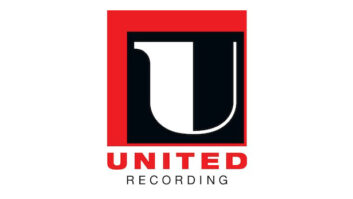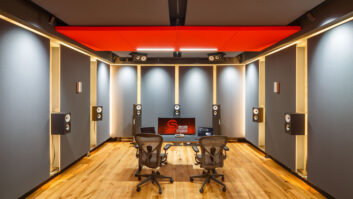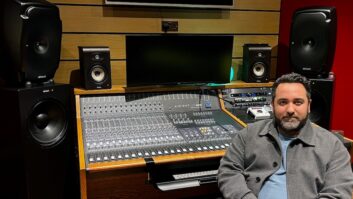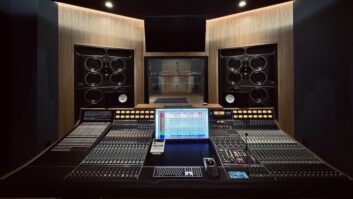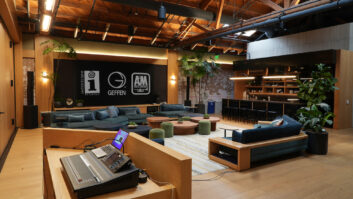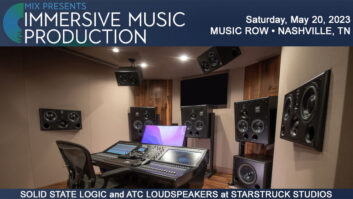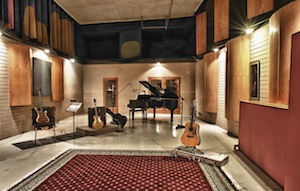
Studio A live room, with space for up to 40 musicians.
Megatrax Production Music knows how to get great sounds, tracks that will pop out of the radio, the small screen or the big screen. And after more than 20 years, the company certainly knows about workflow. They have to. At any one time, the amount of music running through the facility, either in production or post-production, can seem mind-blowing.
As one of the world’s leading independent production music sources for film, broadcast, advertising and multimedia, Megatrax had a choice to make a few years back: The owners could either re-invest in their three-room facility (the former King Sound in North Hollywood, which they purchased in the mid-1990s) and update the infrastructure to take advantage of new technologies, or they could continue apace. They decided on the former, and after undergoing an exhaustive technical makeover last year, the studios are now available for rental by outside clients.
“In doing the renovations, one thing we didn’t want to change was the studios themselves,” says Derek Jones, chief engineer. “Changing the physical appearance of the rooms can have drastic consequences acoustically. The studios have been designed and tuned over the past 27 years to sound perfect, and any changes to the physical space could ruin that sound. So while we did renovations and upgrades to the studio, it was all behind the scenes.”
Studio A is the flagship and the most unique space in the facility. It’s the big room that gives recordings a “big-budget” sound. The live room can accommodate 40 people—enough for large string, brass or choir sections—with its 1,000-square-foot floor plan (including two large iso booths) and 18-foot ceilings. The control room is 700 square feet with a 12-foot ceiling.
While the dimensions haven’t been changed, the equipment selection has been updated, much of it in hardware. Just a few of the additions: a new Avid Icon D-Command 24-channel mixing console; a Yamaha C5 Grand Piano; 34 new and upgraded mic preamps, including 8 channels of API 3124+, 8 channels of True Systems Precision8 and 8 channels of Millennia HV-3D, along with single-channel units from Avalon, Manley, Focusrite and others; 30 new microphones from Neumann, Peluso, Cascade, AKG and others; Pro Tools HD|3—with a Prism ADA-8 I/O; outboard tube compressors from Summit Audio and a solid-state GML 8900 compressor; a Lexicon 300L reverb; and a Furman HDS-16 headphone system.

Studio A control room with guitar amp heads on the producer’s desk.
One of the most noteworthy wiring upgrades is the addition of six speaker tielines and two line-level tielines from the producer’s desk in the middle of the control room to the patch panel in the live room. This gives artists the ability to set up and connect up to six guitar heads in the control room to six speaker cabinets in the live room. The two line-level tielines can carry guitar signals using Radial’s Studio Guitar Interface system to combo amps set up in the live room.
“It definitely makes guitar tracking sessions a whole lot quicker and easier,” Jones says. “We can set up and mike eight amps simultaneously and have them all plugged in and ready to go. Switching amps and guitar tones is as easy as muting and unmuting the mics on the different cabinets now.”
Perhaps the biggest workflow change, however, is that all three studios and six editing stations are now hooked up to a Studio Network Solutions networked hard-drive system. Running on iSCSI and CAT6 gigabit Ethernet, which has a sustained data rate of more than 100 MB per second, producers can record up to 96 tracks of audio at 96kHz/24-bit sampling rate simultaneously in Studio A.
“We have between 10 to 15 projects going on at any given time, all at different stages of production,” Jones says. “We needed a system that can handle all that data simultaneously and be accessed from any and all of the rooms. We can now have all three studios and six edit bays working nonstop on the system while recording those 96 tracks in Studio A, and none of the Pro Tools systems will even see the slightest degradation in performance. This server system also gives us the ability to move projects between rooms instantly. As soon as we finish tracking, we can open up the session in another room for editing and comping.”
Now, after nearly 20 years of requests, the studios are available for rental. Says CEO and co-founder, Ron Mendelsohn: “While many studios have been closing their doors, we have chosen instead to reinvest in our facilities. The ability to record live music and live ensembles in a world-class studio is one of the things that has always set Megatrax apart from our competitors. We intend to not only fully exploit this capability for our in-house productions, but also to make this unique facility available to outside clients on a rental basis.”

